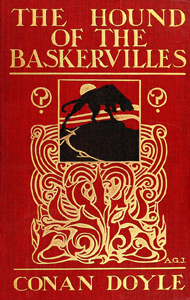In his second-most-famous Sherlock Holmes novel, “A Study in Scarlet” (1887), Arthur Conan Doyle branches into a Western for a while. And in his most famous, “The Hound of the Baskervilles” (1902), he still isn’t totally into the mystery genre. Fans of puzzles that can be solved by noticing clues might find “Hound” lacking compared to later masters like Agatha Christie (although to be fair, Doyle is not necessarily trying to craft a puzzle for us).
The strength of this third Holmes novel is Doyle’s gothic-horror description of the moor behind the mansion of the Baskerville family in the U.K. countryside. It’s a place of bogs, fog, a monstrous dog, rocks, swamps, sometimes even quicksand, and the occasional “island” of a picnic-ready grassy plain. It also has ancient dwellings and archaeological finds.
It’s the perfect place for a supernatural (?) hound to be on the loose, scaring people to death. An 18th century legend holds that an unsavory Baskerville was killed by a giant, vicious hound with glowing teeth. As the 20th century nears, it seems to be happening again, so Holmes sends Watson out to the estate to watch over the newly minted heir, Henry Baskerville.

“The Hound of the Baskervilles” (1902)
Author: Arthur Conan Doyle
Series: Sherlock Holmes No. 5 (the third novel)
Genres: Mystery, horror
Setting: Late 19th century, moor in the English countryside
Watson is also charged with gathering clues in the death of Henry’s uncle, the kindly Charles Baskerville, whose heart attack was apparently induced by the hound, judging by surrounding paw prints.
The mood is the thing
I’m guessing “Hound” – considered by many to be the elite of the four Holmes novels – has its reputation because of its atmosphere. The geological descriptions are enhanced by an escaped convict running loose on the moor (something Christie would pay homage to in “The Sittaford Mystery”) and the Baskervilles’ butler holding a candle to a window nightly, perhaps sending a signal into the muck and mire.
“Hound” is closer to being a puzzle than is “Scarlet” (in which the reader isn’t invited into the game at all), but not because of physical or forensic clues. Instead, we can only examine the behaviors and possible motives of a colorful array of residents around the moor. These include the doctor who brings this case to Holmes, a naturalist brother and his scared sister, a troublemaker who gets involved in local politics for laughs, and maybe even Henry himself.
The biggest clues as to motive – as with “Scarlet” – are discovered off-page by Holmes as Doyle gets caught up in damaged marriages and potential marriages. Multiple characters’ behaviors are guided by whether or not they are married and therefore either trapped in a relationship (as divorce was difficult at the time) or free to pursue someone.

“Hound” is a victim of its hype as the elite Holmes novel and an all-time great mystery. I expected a wild twist at the end, but the revelation of the killer is straightforward and the revelation of the hound’s nature is a mundane afterthought.
If the creature-feature horror seems restrained, you’re not the only one who thinks that. Preston & Child’s 2013 novel “White Fire” invents (and presents) an unpublished Holmes story considered too terrifying for print. The authors surmise that in “Hound,” Doyle censored himself and only went partway down a horrific path.
Not Holmes’ finest hour?
As such, I’m guessing the portrayal of the moor is the thing with this novel, along with strong characterizations and Doyle nudging the genre closer to the age of the puzzle mystery. Interestingly, though, this can’t be considered Holmes’ finest hour.
Yes, he solves the case due to tracking down information. But most of the physical/forensic clues mean exactly what we assume they mean upon first learning about them, and I’m not convinced the sleuth gains much by being on the sideline for much of the novel, handing duties to Watson.
Fascinatingly, although Doyle didn’t intend this, a branch of Holmes scholars contends that “Hound” can be opened up to an entire secondary interpretation wherein Holmes actually got this solution wrong! I do get a sense that Doyle didn’t have this plot totally nailed down. In the epilog, Holmes’ theory about the killer’s broader plan reads like an apology.
Among the most interesting analyses of “Hound” appears to be “Sherlock Holmes Was Wrong: Reopening the Case of The Hound of the Baskervilles” (2008), in which Pierre Bayard argues that Holmes came to the wrong deductions based on the information available.
A deeper dive into “Hound of the Baskervilles” scholarship and theories will likely be fun, but looking strictly at the text on the page, I’m surprised the novel is so celebrated. It gives me an excellent picture of English moors, and I appreciate it as a mood piece, but the mystery is merely acceptable – not the next level of genius one might expect from the hype.
Sleuthing Sunday reviews the works of Agatha Christie, along with other new and old classics of the mystery genre.

